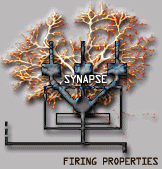 ARCHITECTURE, SPACE AND THE HARD PROBLEM
ARCHITECTURE, SPACE AND THE HARD PROBLEM  ARCHITECTURE, SPACE AND THE HARD PROBLEM
ARCHITECTURE, SPACE AND THE HARD PROBLEM One "phenomenal consciousness system", for short, P-consciousness, hypothesis: "It is plausible that consciousness in some sense requires the activity of neurons" (Crick F), neurons which could be identified as a module, as a part among the whole brain. Modules are individuated by their function. First there are specialized modules (i.e., the logical module or "problem space", or "concept space", the module of prior dangerous experience, the module of positive contributions--a part of the previous module if interpreted as the danger of missing an opportunity--, the module of creativity, the module of cognitive-based feelings and emotions). Second, there is also an Executive module or system (i.e., the von Neumann's bottleneck). And third, there is a single system that has the managing function of
But there is an additional compromise to call that single system the phenomenal consciousness system, namely to say that P- consciousness is somehow involved in performing that function. And the same questions about the A-consciousness, the access, the Operating System hypothetical neurons.
Which consciousness-related neurons are they? Where are they? What particular neurochemistry do they employ? Do they have special connections? Do they fire in an unusual way? When known, and evaluated its relative importance in the whole picture, may then most previous literature appear out of context? The future emerging picture of our neuronal operating system, the view that consciousness occupies a literal place in the brain, may be a sample of complex and hard-to-digest knowledge, full of information content, namely to know, if true, that phenomenal and address consciousness are somehow performing and involved in a neuronal function.
A second "feature of the whole brain" hypothesis: One can accept the idea of phenomenal consciousness as distinct from any cognitive or functional or intentional notion while frowning on a modular treatment of it, i.e., a literal place, a theater in the brain at which "it all comes together" for consciousness. Perhaps, for example, phenomenal consciousness is a feature of the whole brain. Many investigators will hate any model that treats phenomenal consciousness as something that could be accomplished by a distinct system at a distinct place. See, for example, Dennett and Kinsbourne's (1992) view about consciousness occupying a literal place in the brain.
In the meanwhile, we know that this operating system can cover both lower and higher control functions. It seems as that our consciousness does not have access to the details of their operations but only to the results emerging from the "unconscious" to the "conscious". By introspection we have access to only a limited amount of what is going on in our brains. We have no access to the many operations that lead up to the information given to the brain's operating system. The reason is clear if one accepts that the parallel subnets computing simultaneously are hidden to the von Neuman's-like processing unit serial bottleneck. Crick p 205
So we can believe that the operating path, the operating system cascading through very different parallel locations, is making a contribution mostly trying to follow downhill bioenergetic patterns, with the help of blood glucose and hormones flowing out of less needed brain regions to more involved brain networks, to avoid either primitive or elaborated danger states.
A theory of brain's operating system would tell us how the brain works. It would be integrated in two senses.
Such a theory would be a solution to the philosophical separation between mind and brain that was expressed in the theory of Rene Descartes. It may show the Marvin Minsky's simple synthesis: A-brain neurons are in contact with the outside world and the internal organs, and are informed about them, and B-brain neurons are in contact with A-neurons and are informed about them and can control them, control that is not only particular but also overall. A-brain is the common brain of the brain/mind set, B-brain is the mind.
Such an integrated theory is not yet at hand, but Posner and Raichler express that there is a sense in which the PET - positron emission tomography -"images of mind" (their most interesting experimental differences between blood flow before and during mental actions) have rendered the mind-brain separation obsolete, "at least at the everyday working level at which science is done". These investigators detect at their laboratories, the shift of attention, the visual word form, or the system responsible for target detection at the cognitive level - so describing a sequence of mental operations. They design and execute experiments to see where those operations occur in the brain. Each experimental design goes from the cognitive to the anatomical or the other way arond. "Experiments in research centers throughout the world now move effortlessly between the description of mind and the anatomy of brain as though there had not been the centuries of philosophical disputation about whether it is even possible." (Posner and Raichler)
NEXT
OTHER
2.feb.1999
Pulsar tecla de vuelta
Glosario de Carlos von der Becke, where some specialized words are explained.